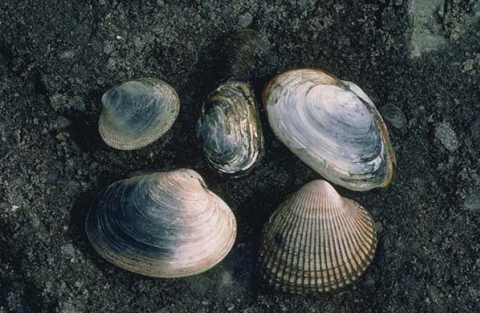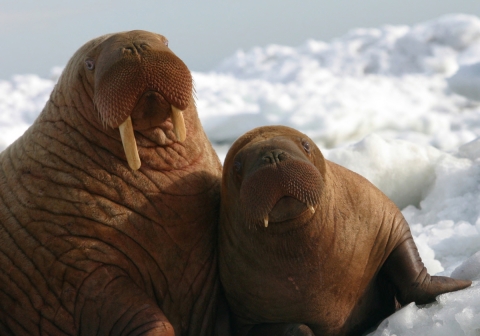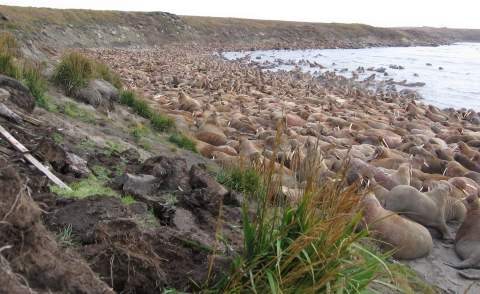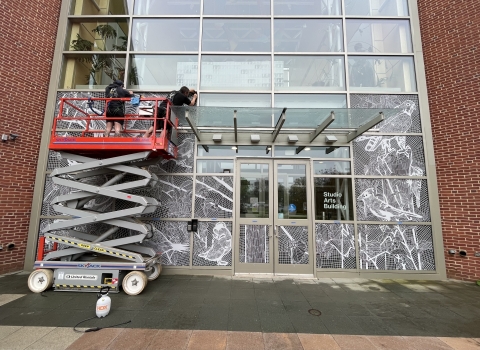Joel Garlich-Miller has been a walrus biologist with the U.S. Fish and Wildlife Service (Service), Marine Mammals Management office in Alaska for more than three decades. Over the course of his career, he has worked with and learned from Alaska Native hunters to develop a shared understanding of the walrus population and outlook for its future in a changing Arctic. Joel grew up in Canada and at a very early age was fascinated by wildlife and was an avid outdoorsman. As an undergraduate, he was fortunate to land a series of summer-seasonal jobs as a technician working in Arctic Canada for the Department of Fisheries and Oceans. “It was a fantastic opportunity to participate in field work tracking marine mammal migrations through the Arctic sea-ice, monitoring walrus haulouts on remote Arctic islands, and working with Inuit hunters in remote Arctic communities to collect samples from harvested marine mammals,” Joel explained.
As a graduate student, Joel spent long summer months living in temporary hunting camps along the Arctic coast working with walrus hunters to document their harvests and collect biological samples to investigate the biology, ecology and health of the walrus population. In 1993 he presented some of his graduate work describing walrus reproductive rates at a marine mammal conference where he met some Service biologists from Alaska. This led to an exciting outcome, Joel said: “They encouraged me to apply for a position as a walrus biologist and I got the job!”
With decades of experience in Pacific walrus research and deep connections to both science and traditional knowledge, Joel's work has given him unique insights into the challenges and opportunities of studying these iconic Arctic mammals. In this interview, he provides valuable insights into the current state of Pacific walruses, the impacts of changing sea ice conditions, and how science and traditional knowledge work together to guide conservation efforts in the Arctic.
What are your job duties with the MMM office?
The Pacific walrus is a trust resource of the Department of the Interior. Our management activities are guided by the Marine Mammal Protection Act (MMPA) which protects marine mammals in United State’s waters. I am part of a team that is responsible for tracking the population status and trends, mitigating the impacts of commercial activities on walruses, and working with Alaska Native partners on the co-management of subsistence harvests.
What can you tell us about Pacific walrus?
The Pacific walrus is represented by a single stock of animals that inhabits the shallow ice-covered waters of the Bering and Chukchi Seas. The population ranges across the international border of the United States and Russia.
Walruses are an incredibly important subsistence resource here in Alaska. For thousands of years, walrus hunting has been an important part of the culture, economy, and food security of Indigenous communities living along the Bering and Chukchi sea coasts.
Walruses are specialized predators of clams and other invertebrates. They have a face full of highly innervated whiskers which allows them to locate prey items by feel in the murky sediments. They use a giant powerful tongue to express jets of water to quickly excavate deeply bedded clams. They take clams into their mouth, create negative pressure with their tongue to break the abductor muscle, suck the meat out, and spit the shell out in a matter of seconds. Walruses can be thought of as gardeners, rooting around the bottom of the ocean, pulling up sediments which improves nutrient flow.
Although walruses can swim for a week or more, they must periodically haul out onto sea ice or land to rest. Sea ice is particularly important habitat for females and calves. It provides a platform for accessing offshore feeding areas, isolation from terrestrial predators, and provides a sheltered environment for young animals against stormy seas. When suitable sea ice is not available, walruses come to shore to rest on land.
How is a warming Arctic affecting the walrus population?
Most of the Pacific walrus population spends the summer months foraging across the shallow continental shelf waters of the Chukchi Sea. Historically sea ice persisted over offshore areas throughout the summer melt season. However, during the course of my career, there has been a drastic shift in the extent of summer sea ice which now routinely retreats completely off the shallow continental shelf where walruses feed — with periods of no ice cover ranging from a few weeks to as much as 3 months. When sea ice recedes over the deep ocean basin, walruses abandon the ice and move to coastal areas where they can rest and access foraging areas from land. Over the past twenty years, the number of walruses using land-based haulouts along the Chukchi sea coast has increased dramatically. Beginning in the early 2000s, we started hearing reports of large coastal haulouts forming in Chukotka, Russia.
We have seen a similar pattern develop here in Alaska since 2007, with large haulouts forming in late September to early October at several locations along the coast of Alaska. The size of some of these haulouts is very impressive with tens of thousands of animals hauling out in some locations.
One of the biggest conservation and management concerns associated with these large densely packed coastal haulouts is the potential for injuries and mortalities associated with stampedes caused by disturbance events. Disturbances can be caused by human activities such as aircraft over-flights or sometimes by natural sources such as polar bears drawn to the haulouts. Our strategy to minimize human disturbances at coastal haulouts includes targeted outreach efforts to commercial pilots and mariners, local public service announcements, and village visits to raise awareness of the potential for disturbances.
Some of the most important and effective efforts to minimize disturbances at coastal haulouts are occurring at the local level. Several communities in Alaska and Chukotka, Russia have taken steps to develop local management programs to minimize impacts to walruses resting on shore. Their efforts have resulted in some solid and positive conservation actions, including self-imposed hunting restrictions at the haulouts, re-routing supply flights, and developing viewing guidelines to reduce disturbances.
In Alaska, the Native village of Point Lay in particular has taken on a very active and effective stewardship role to protect a large walrus haulout that forms each fall near their community. The community has worked very hard to monitor and manage human activities near the haulout to prevent disturbance events and trampling injuries and mortalities.
What are some other ways Alaska Native people are involved in walrus conservation, research, and management?
Over the course of my career, I have had the opportunity to work closely with subsistence walrus hunters from Arctic Canada, Alaska and Chukotka, Russia and most everything useful I have learned about walruses has come from these interactions.
Here in Alaska, walruses are a very important subsistence resource. The MMPA provides a framework for the co-management of walruses in Alaska. Since 1997, the Service has had a formal co-management relationship with the Eskimo Walrus Commission (EWC), which is composed of tribally appointed commissioners representing the primary walrus hunting communities in Alaska. The Service and the EWC have collaborated on a wide variety of successful co-management projects over the years including walrus harvest monitoring and biological sampling projects; joint meetings with oil and gas industry representatives to develop mitigation measures to prevent disturbances to walruses and walrus hunters; and the development and promotion of community-based haulout management efforts. The EWC has also sponsored the participation of expert walrus hunters in our research cruises, and their knowledge of walrus biology and behavior and skills in navigating and operating in dynamic ice habitats has proven critical to our success in finding and sampling walruses out in the sea ice.
Community-based conservation and management efforts are becoming increasingly important. The Service works in close collaboration with coastal communities to monitor and respond to stranded walruses and protect coastal haulout areas such as the one in Point Lay.
Walrus managers and hunters both recognize that the loss of sea ice habitats and increased industrial activity in the Arctic pose challenges to walruses and to hunting safety and success. We recently collaborated with the EWC and several Indigenous Knowledge holders on a walrus population model, developed by my colleague Devin Johnson (FWS), that simulates the future status of the Pacific walrus population under various ice loss and disturbance source scenarios to identify sustainable subsistence harvest levels into the future. There are several key knowledge gaps about walrus biology and behavior absent in the scientific literature that we were able to address through the expertise of the Indigenous Knowledge holders. The collaboration allowed us to corroborate and compare Western science knowledge and assumptions with Indigenous Knowledge. It led to two published journal articles (Co-producing knowledge about the Pacific walrus and climate change and Assessing the sustainability of Pacific walrus harvest in a changing environment). A variation of this model was also recently used in a Species Status Assessment to describe the status of the Pacific walrus population under future climate change climate change
Climate change includes both global warming driven by human-induced emissions of greenhouse gases and the resulting large-scale shifts in weather patterns. Though there have been previous periods of climatic change, since the mid-20th century humans have had an unprecedented impact on Earth's climate system and caused change on a global scale.
Learn more about climate change scenarios to inform a listing determination under the Endangered Species Act.
How does the Service track the walrus population?
Walruses inhabit one of the most remote and dynamic regions on the planet. They occur in patchy aggregations across an enormous range of shifting sea ice habitats. Back in the day we used to conduct aerial surveys to census walruses hauled out onto sea ice and used satellite telemetry to account for diving behavior to estimate what proportion of animals we missed. Although we invested enormous effort into these surveys, the resulting abundance estimates were plagued by very large confidence intervals— in other words, they were not very precise—which made it difficult to interpret population trends.
Starting in the mid-2010s we adopted a genetic mark-recapture approach to estimating abundance. The idea behind the “mark-recapture” method, which is commonly used in wildlife biology, is that the more animals there are, the less likely we are to encounter the same individual animal more than once. If we put a mark on animals the first time we capture them, and then later recapture animals and count how many have marks, we can estimate the population size. For genetic mark-recapture, we identify individuals using their unique DNA profile instead of a visible mark like a tag.
So about 10 years ago, we initiated a series of walrus research cruises to collect skin biopsies for DNA analysis from free-ranging walruses out in the pack ice and collect information about the age-sex composition of the herds. DNA profiles function as marks and allow us to calculate recapture rates from one field season to the next, which provides a basis for estimating abundance, and the walrus demographic data is used to estimate reproductive and survival rates for the population. As I mentioned earlier, the EWC has sponsored the participation of expert walrus hunters in the research cruises, which has been invaluable.
The precision of the population estimates from our research cruises is significantly improved over our previous aerial survey estimates. The most recent population estimate suggests that as of 2017, there were about 250,000 walruses in the population. We recently began a new series of walrus research cruises led by my colleagues Irina Trukhanova (FWS) and Bill Beatty (USGS) to get a handle on the latest population trends and dynamics.
What is your outlook for the future of walruses in Alaska?
Currently, the walrus population in Alaska is large and healthy. Subsistence harvest levels are well within a sustainable range and walruses have demonstrated quite a bit of adaptability and resiliency to the effects of sea ice loss thus far. The future is uncertain but has not yet been written. The loss of sea ice habitats is resulting in changes in the whole Arctic ecosystem, including walrus distributions and habitat use patterns. If this pattern continues, the Pacific walrus population will likely decline. I believe, however, that there are things we can do to keep walruses as a functioning part of the ecosystem and a sustainable resource for future generations. I am really heartened by the conservation ethic and stewardship efforts demonstrated by the Alaska Native communities and believe that investments in local management efforts to protect walruses at coastal haulouts and maintain sustainable harvest levels can have a significant positive influence on the future Pacific walrus populations.
It’s been a great honor working for the Service on its wildlife conservation mission. I am thankful for the opportunity to study this amazing animal and work with so many remarkable people. Now at the tail end of my career, I am extremely grateful for the next generation of walrus researchers and biologists that have joined our team in recent years. They are very smart and dedicated individuals, and I am confident in their abilities to face whatever challenges lie ahead.











